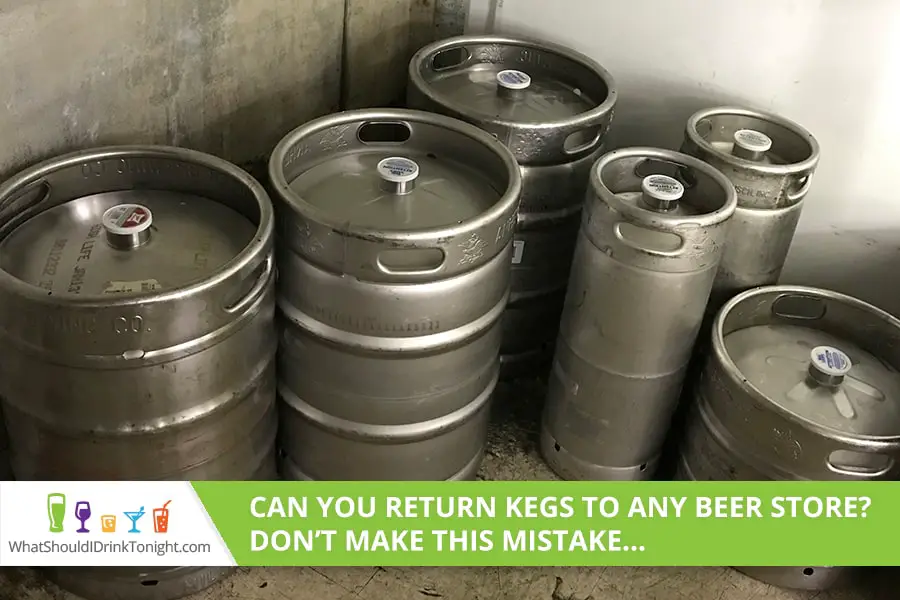I recently threw a party and bought a keg of beer at a beer store somewhat nearby. My local store was all out of kegs of the beer I wanted so I had to drive about 20 minutes to purchase the keg. When the time came to return the keg to the beer store I didn’t want to drive all the way out to the original store and wondered if I could just return it to my local store. A quick search online turned up the answer.
So, can you return kegs to any beer store? Kegs should always be returned to the place where you obtained them. The keg is the property of the vendor who originally filled and sold it to you and should be returned to that same vendor.
Whenever you put a deposit down for a keg, it means you are renting it, which many consumers misunderstand. If you try to return it to another store it will most likely be rejected because of keg registration laws. This will leave you without your deposit money and the vendor without their precious keg. Talk about a lose-lose situation!
Well folks, after finding all this out I did a deep dive on beer kegs and found some great information that I’d like to share with you, so read on to learn how not to get arrested when returning a keg!
Things to Know When Returning a Keg
Here are some important things to know when returning a keg to the store:
Keg Registration
Many states have a keg registration law which requires retailers and wholesalers to attach an identification tag to a keg that exceeds a specified capacity of 2-8 gallons minimum depending on the state you are in. Although keg registration is mainly to help reduce underage drinking, it also helps with identifying who the keg belongs to.
When you obtain a keg, the retailer should record your identifying information such as name, address, driver’s license, and telephone number. They will also collect a deposit which is refunded at the time the keg is returned. The keg must be returned with the ID tag intact. In some states there is a penalty, or it is considered a crime if you have an unlabeled or unregistered keg.
Empty Kegs
Kegs are made of tin, aluminum, or stainless steel. An empty keg can be worth $15 to $55 in scrap. But, before you try to take an empty keg to a beer store or scrap it, be sure that the manufacturer’s name is not stamped on it. If it is, you are not allowed to sell or scrap it. You must return it to the manufacturer if you know where it came from.
Manufacturers label their kegs with serial numbers so they can track which stores, bars, or restaurants are in possession of their kegs. If one of these establishments reports their keg(s) as stolen and you try to turn it in for a reward, you may be unpleasantly surprised when an officer slaps the cuffs on you!
Keg Theft
Kegs are expensive, and large breweries purchase tens of thousands every year at approximately $100 apiece. It is especially costly for breweries that lose kegs every year through misplacement or theft. Larger breweries actually lose approximately 10% of their kegs annually.
Because beer keg theft is so rampant, fewer vendors and scrap yards will even purchase empty kegs. However, there are some commercial outlets and liquor stores where you can get in-store credit or cash. But if you rented a keg for an event, you must return it to the place where you got it. With kegs being so expensive, it’s understandable why businesses do not want to keep replacing them.
A beer store that takes a keg from you when you have received it from another retailer may be breaking the law. Many stores will refuse a keg, especially if it is labeled with the brewery where it came from.
Keg Management
With all of the above being said, some companies have sprung up to help provide a solution to the small keg crisis.
As of 2019, there are over 7,000 breweries operating in the United States. Managing and tracking kegs is a huge undertaking that many small breweries do not have the money, time, or resources to handle. But the loss of kegs is an even bigger financial hit to breweries. Companies like MicroStar are providing solutions.
MicroStar’s warehouse in Green Bay, Wisconsin, spans 100,000 square feet and houses approximately 200,000 kegs. Tracking and returning, buying, transporting and maintaining kegs can be costly for brewery owners. MicroStar works with the Brewer’s Association to find the largest pool of stray kegs, pays the deposits for them, and coordinates their delivery back to the warehouse in Green Bay. From there they work on returning the kegs to their rightful homes.
Know the Laws in Your State
The next time you go and pick up that keg of beer and put a deposit down, remember, you are renting, not buying. Even if you purchase a beer keg, make sure you know the laws that apply to your state. For example, in Louisville, Kentucky, House Bill 136 was passed in 2018, which allows consumers to purchase up to 31 gallons of beer directly from Kentucky microbreweries.
Previously, it was illegal. In 2015, the Brewers Association and MicroStar sent a letter to eBay requesting that they no longer allow the sale of used kegs without proof of sale. It’s important to know the laws relevant to kegs in your state, or you might find yourself on the wrong side of the law!
What Do People Use Empty Beer Kegs For?
Many consumers don’t give it a second thought when they decide to make use of an empty beer keg. They think that if they don’t take it back, the store has their deposit, and they can do what they want with the keg. Wrong!
The deposit is a good faith promissory note that you will return the keg to that store. But people will try to use them as hot liquor tanks, boil kettles, or mash tuns to brew their own beer. Then there are the creative crafts like coffee tables, bar stools, lighting fixtures, and even urinals. What consumers do not realize is that they may have (probably) illegally acquired and are often tampering with the property of a brewery.
The Basics of Kegs
Now that we know what to do once the keg is empty, we should definitely know how to empty it!
So, your big event is coming up, and you have rented your beer keg. Now you want to make sure the beer tastes just right, and the keg works properly. When you rent the keg, vendors will also rent you a tap to serve and drink the beer. Here is some basic keg information and some tips to ensure your brew is perfect!
Types of Kegs
Below is a table of common beer keg types and their capacities.
| Keg | Capacity (gal./oz) | Pints | Cans/Bottles |
| Mini Keg | 1.32/169 | 10.6 | 14 |
| Half Barrel | 15.5/1984 | 124 | 164 |
| Slim Quarter | 7.75/992 | 62 | 82 |
| Quarter Barrel | 7.75/992 | 62 | 82 |
| Sixth Barrel | 5.16/661 | 42 | 56 |
| Cornelius Keg | 5.0/640 | 40 | 53 |
Keg Valve Systems
There are various types of valve systems, and tapping them requires slightly different steps. American breweries generally use the “D” system, but when it comes to imports, it can get confusing. Valve systems include:
- American “D”
- European “S”
- “U” System
- German “A”
- German “M”
Check with the vendor to confirm the type of valve system you have. Tapping the keg basically means attaching the valve system to the keg and engaging the tap so the beer will flow smoothly. You will know if the pump is not seated on the keg correctly if you see bubbles or foam escaping from the tap. It is normal for the first pint to come out as foam, but beer should follow shortly after.
Benefits of a Keg
If you are hosting a party or event, people will most likely want more than one beer. A keg offers a few unique advantages for your get together such as:
- Kegs are cost effective, much cheaper than buying canned or bottled beer.
- No bottles or cans lying around.
- Better quality beer.
- Kegs are more environmentally friendly due to their reusable nature.
- Kegs are much more fun for your guests to use!
Just make sure you return the keg to the proper place!
Keep it Cold
The most important thing when dealing with any keg is that you want to make sure the beer is nice and cold because no one likes warm beer! Here are a few tips to make sure the keg stays cold:
- Cool the keg before you tap it.
- There are containers that the keg can fit in, or you can use a large garbage can filled with ice.
- Situate the keg where you want it because it is heavy, and you don’t want to keep moving it around.
- Let the keg sit on ice for several hours, which will help prevent cups and cups of foam.
- The tap should also be iced otherwise it will lose carbonation when the cold beer hits the warm tube on the tapping system.
- Sit the tap on ice for approximately 1 hour.
Well folks, I hope you know where you need to return your keg to next time you rent one, as well as how to enjoy the overall keg experience!

